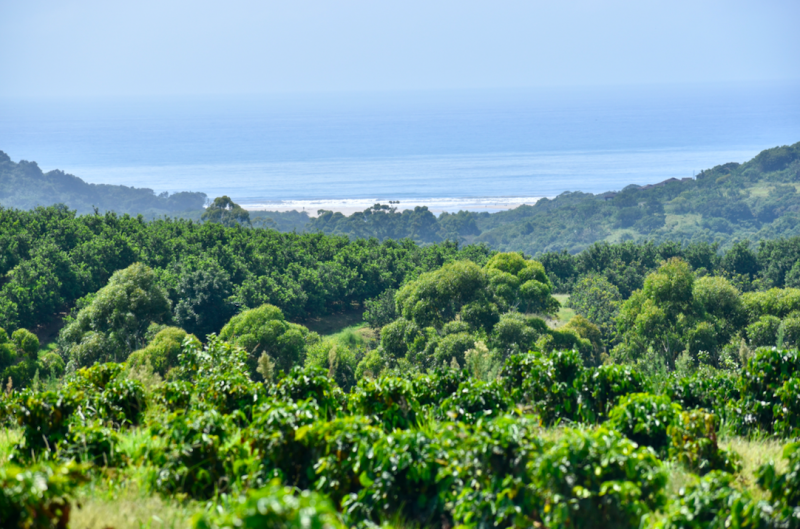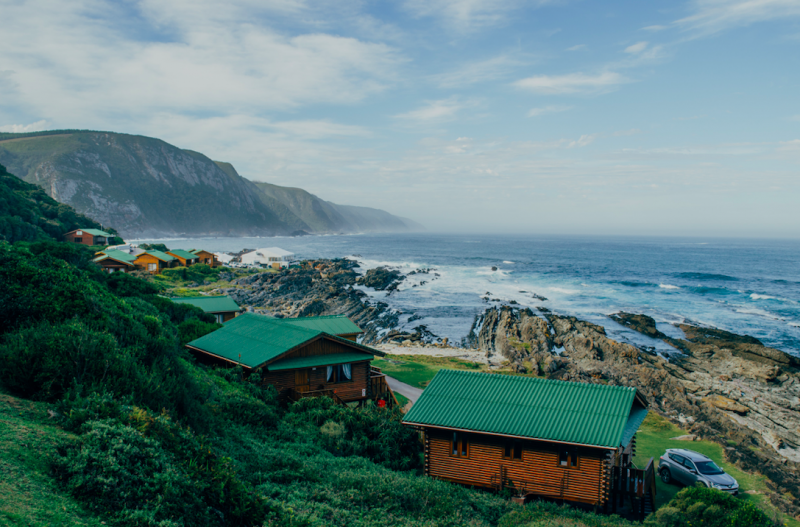The accepted wisdom about coffee farming conditions is changing. Rory Kleu, an agronomist, investigates the possibilities of low altitude grown coffee and smashing the myths of the coffee belt.
Most coffee drinkers have heard from their local coffee professional that coffee is grown between the tropics, known as the Coffee Belt. This is largely due to a combination of altitude and temperature conditions, but in an ever-changing world at the mercy of climate change and disease, alternatives to the norms are being explored and this has exciting implications for the Southern tip of Africa. Rory Kleu has been an agronomist for 15 years, driven by finding solutions to agricultural challenges, he has covered over 20 different crops across all 6 continents upon which farming is practiced. And recently his focus has shifted to coffee…
Words by Rory Kleu

Coffee is a crop unique in many ways. The allure of plantations in deep jungles and cloudy equatorial mountains forms a significant part of what fascinates us about this particular agricultural product. Yet somewhere in these tropical mists lies hidden a line between fact and fiction regarding coffee’s agronomic requirements. In deciphering the science from the romance, a story emerges no less enchanting than the one we’ve always imagined.
In our pursuit of quality coffee, of prime importance is altitude. High altitude equals high quality. This is gospel. But why? What measurable environmental conditions do coffee trees enjoy further up a mountain, that they lack growing closer to the sea?
With an increase in elevation away from sea level (from 0 - 2 500 m in the context of arabica coffee’s potential range), come many environmental changes that affect a plant’s growing conditions. Temperature decreases, whereas rainfall and cloud cover increase. Air pressure also decreases resulting in a lower effective availability of the gasses that sustain plant life – oxygen and carbon dioxide. Conversely, the relative amount of water vapour in the air, humidity, increases. Light changes too, with UV radiation increasing. These changes in atmospheric conditions cause changes to the Earth’s surface as well, with higher rainfall resulting in soils becoming more acidic and less fertile. The effects of the more easily measurable of these factors on plant growth are well known. And so, we know accurately what temperature range (difficult to manipulate outside of a greenhouse), and amount of rainfall (easy to increase with irrigation) will give the optimum coffee crop yield and quality. Whilst the significance of the effects of the somewhat mystic variables, such as light frequency, have yet to be fully demonstrated scientifically.

Young coffee trees grown on the KZN south coast at Mpenjati Farm, between 500-600masl. Photo credit: Coffee Magazine
The climatic conditions in which arabica coffee evolved are wonderfully special. They express themselves as one of our planet’s most delicate Goldilocks zones. Forming a micro-climate fragile in existence, yet more gently nurturing than any other. One no better described than in the words of Karen Blixen, “Up in this high air you breathed easily… you woke up in the morning and thought: Here I am, where I ought to be.” In coffee’s chrysalis the temperature would never drop much below 18 °C, nor peak far above 22 °C, any time of day, and any time of year. Just the perfect oscillation between the very edges of cool and warm. But what pattern of geography can permit the expression of such narrow atmospheric consistence? Tropical highlands. Tiny pockets of these fair conditions are chiefly found inside primeval forest groves, at 1 000 – 2 000 m elevation and within 10 ° of the Equator.
Fortunately, coffee can still grow slightly beyond this limited range. However, straying too far from it has negative effects. Once temperatures drop too low, yield decreases, and if they rise too high, then cup quality declines sharply.
Frost will kill the coffee plant. Excessive heat causes premature ripening of the crop which prevents the elements of sought-after flavours to develop within the seed. And so, the closer to the perfect parameters of temperature that coffee is grown, the better. Since there are relatively few places on Earth in which this confined zone naturally occurs the vast majority of the world’s coffee crop is produced outside of this ideal reach. Hence the reason why we pay what we do for specialty coffee.
Planet Earth however, is full of surprises. Sometimes totally different geographic features can give rise to similar conditions of climate.
Phytogeography and geobotany are the mirror studies of plants’ influences on the Earth’s surface and geographic space’s influence on plants, respectively. The insights gained from these fields of inquiry can be applied to the science of crop growing. To explain the distribution of flora across the different climatic zones of the globe, Linnaeus surmised that all the plants of the world had been created on a mountain positioned on an island situated on the Equator. The arctic plants grew near the summit, the temperate ones at mid-altitude, and the tropical plants near the coast. These different species then dispersed to their eventual homes around the Earth. On this fictitious island of botanical origins, altitude had acted for latitude to provide the necessary temperatures of the different climates.
One of the most aesthetically informative graphic representations of this notion was done by the German explorer, Alexander von Humboldt. He drew Mt Chimborazo, in Ecuador, with its vegetation zones and corresponding elevations superimposed. This is the highest mountain found on the Equator, and because our planet bulges around the middle, it’s the point on the Earth’s surface furthest away from the centre of the Earth. In the milieu of coffee quality, we sometimes hear about a higher latitude being able to substitute for a lower altitude, and as the old botanists showed us, this is true. To an extent.
Challenging the notion that coffee is a high-altitude crop are a few interesting findings. Coffee was grown successfully in colonial Natal as far back as the 1840’s, with production peaking in 1872. It’s enlightening to note where else coffee production peaked in 1870. Ceylon. Though plant pathologists often recount why Sri Lanka’s coffee industry collapsed, and what long-lasting consequences this had on shifting British culture from coffee drinking to tea drinking, seldom is the story of coffee leaf rust’s effect on stifling the development of coffee farming in South Africa ever told. Nonetheless, for the past 180 years coffee has continually been grown in coastal KwaZulu-Natal.
The significance of this is that KZN lies outside of the tropics. At 30 °S it’s a region that should be too cold for growing a tropical crop. The latitude here lowers the temperature at lower altitude, but too much. It is only the influence of the warm Agulhas Current of the Indian Ocean, flowing south from the Equator, that moderates the climate of South Africa’s east coast enough to allow crops like sugar cane, bananas, pineapples, tea, and coffee to thrive. None of these crops, that are farmed commercially between East London and Durban, are done so within the same latitude range at Vredendal, Valparaiso, Porto Alegre, Perth, Sydney, San Diego, Charleston, or Shanghai. The main reason is that all of these locations get too cold in winter.
Along and just beyond South Africa’s Wild Coast, the influence of the ocean on atmospheric temperature, surpasses that of the latitude. The average annual air temperature range at Port Edward, the epicentre of the KZN south coast coffee route, is 15 – 24 °C. And the reason for this relatively narrow range can be appreciated by referencing it against the average annual sea temperatures at the same location, which are 19 – 27 °C. However, travel inland and rise up to just 450 m elevation, and you’ll encounter frost in winter. The ocean’s breath tempers only a confined strip of mild climate along the coast. The relevance of maritime influence on climate is not new. Rachel Carson called this the global thermostat. Consider the impact of the Gulf Stream on life in far northern Europe. Interestingly, where the Gulf Stream intercepts the Mid-Atlantic Ridge you find the Azores Archipelago, and the thin coastal bands around these islands provide the most poleward frost-free areas on Earth at 36 – 40 °N. Oh, and guess what crop you’ll find growing there? Coffee.
It seems then that instead of asking what altitude the coffee was grown at (to gain an indication of its potential quality), the more pertinent question to ask is what temperature range it was grown in. In Tanzania, arabica coffee is grown in 10 – 25 °C at the base of Mt Kilimanjaro.
It is also grown in 22 – 32 °C on Zanzibar. Zanzibar Island coffee, grown at less than 100m elevation and surrounded by the sultry Azanian Sea, is sold as a novelty and not for its brilliant flavour profile. Because we know that the 1 200 m elevation of the Kilimanjaro coffee is what gives the required temperature range, this is what we’ve always called good altitude coffee. Even though Africa’s loftiest peak reaches to 5 895 m, our high-altitude grown coffee is from only a fifth of the way up. On the Equator the frost line is just below 3 000 m. Hawaii’s famous Kona coffee is grown in 16 – 26 °C, but the Kona coffee belt lies between only 200 and 600 m elevation. It’s the Pacific Ocean that provides the ideal temperature range. Let’s call this good oceanic coffee.
The two larger Mascarene Islands, Mauritius and Reunion, are situated in the balmy Indian Ocean at roughly the same latitude south as what Hawaii is north, around 20 °. Mauritius is low-lying and too hot to grow coffee of any prized value. The erstwhile Bourbon Island produces highly sought-after coffee in 12 – 28 °C, at elevations between 150 and 1 000 m. There the temperature range is made possible by the latitude-tempered altitude. This is also good altitude coffee.
On St Helena Island, out in the lonely, cool south Atlantic Ocean, the exiled Napoleon’s only comfort is said to have come from the locally grown coffee, that he rated as the best in the world. On St Helena coffee is grown in 19 – 25 °C, at around 500 m elevation. Yet this island lies 5 ° closer to the Equator than Reunion. Here, the overriding factor that brings the air temperature so close to coffee’s most suitable range is the ocean rather than the altitude or latitude. St Helena’s, is sublime oceanic coffee.
By far the most remarkable cooling effects of an ocean current on terrestrial life are to be found on the Galapagos Islands. Thanks to the chilly temperature of the Humboldt Current flowing up from Antarctica, amongst its numerous wonders, this equatorial archipelago provides a habitat suitable for penguins. And with a temperature range of 12 – 28 °C, at an elevation of just 100 – 600 m, shall we call the singular coffee being grown there oceanic?
The species of coffee indigenous to the Ethiopian Highlands grows naturally as part of a particular plant community. This vegetation type is called Afromontane Forest. It’s a distinctive biome that occurs discontinuously across the length of Africa, with the isolated patches being separated from each other by lower-lying regions. This characteristic has led to them being referred to collectively as the Afromontane Archipelago, because their distribution is analogous to a series of islands in the sky. At the southern tip of the continent, the very same classification of vegetation reaches right down to the lapping ocean in the 25 000 ha Knysna-Tsitsikamma forest. And with an average annual temperature range of 13 – 20 °C, Knysna’s oceanic climate may provide not only one of the most fitting locations for growing exceptional quality coffee in South Africa, but indeed in the world.

The Tsitsikamma Forest, a new landscape for coffee growing? Photo by Mateus Maia
The link between high-elevation grown coffee and coffee cup quality will prevail, just as the interplay between latitude and altitude remains relevant. Yet neither of these phenomena act in isolation, nor are they absolute. A new narrative on coffee quality, based on understanding the reasons behind climatic and agronomic influences, would benefit both coffee farmers and coffee drinkers alike. Low-altitude ocean-moderated areas are capable of producing extraordinary coffee. These coastal belts result in climatic conditions not only suitable to the production of coffee, but of a quality which has hitherto only been ascribed to the high-altitude regions.
Finally, consider this question: which would you be prepared to pay more right now, for a bag of beans grown at 2 000 m in Colombia or Kenya, or for one grown at a mere 200 m on St Helena or the Galapagos?
Welcome to the world of oceanic coffee!